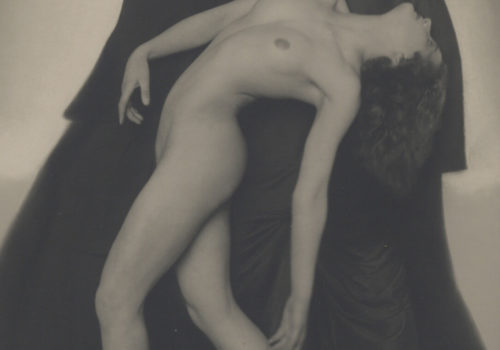Kicken Berlin presents the exhibition Rudolf Koppitz and other European Masters as well as a selection from Gundula Schulze Eldowy’s Berlin in einer Hunde- nacht/Berlin on a Dog’s Night (1977–1990).
Rudolf Koppitz
Rudolf Koppitz (1884–1936) may be considered Austria’s most prominent inner-war-era photographer. His life’s work spans both a variety of pictorialist imagery as well as the clear aesthetic of modernism’s New Objectivity around 1930. His Bewegungs- studie/Movement Study of three black-robed dancers with a female nude from 1925 is his most celebrated image and simultane- ously an icon of photo history. The image unites the elegance of the flowing lines of Viennese art nouveau with the precise, sharp gaze of the modern. Koppitz interpre- ted this motif using various techniques, from rich pigment and bromoil prints to sil- ver gelatin prints.
Less well known but no less bold in their abstraction are the cloud studies taken by Koppitz as a surveillance pilot from an open airplane during World War I. Furthermore, Koppitz’s self portraits hiking through the mountains and pictures of his powerful exposed body attest to a confident, new self- representation of vital physicality in accord with the nature of the mountains. In additi- on to the artist’s stupendous mastery of such various printing techniques, Koppitz is known for his subtle, strict, and yet harmonious compositions, the spectrum of which ranges from the elegance of the Bewegungsstudie and nudes to the seemingly cropped, monumental abstractions of statuesque figures of the Heimatphotographie (home- land photography) movement from the 1930s.
Koppitz himself considered the triptych of images Mutter und Kind/Mother and Child (his wife Anna with their daughter Liselotte), Bewegungsstudie, and the self-portrait Im Schoße der Natur/In the Lap of Nature to be among his most important works. A large- format version long hung prominently in his atelier. Here the study of fertility, eroticism, and self-perception can be experienced in a more intimate format in three clear silver gelatin prints
Kicken Berlin embeds the work of Rudolf Koppitz, long-time professor at Vienna’s Graphischen Lehr- und Versuchsanstalt fur Photographie, in the context of the Central European avant-garde.
In particular his contemporary Heinrich Kiihn and Czechs Karel Novak, Josef Sudek, and Frantisek Drtikol and Hungarian Ferenc Haar enrich the Austrian’s aesthetic world with their portraits, nude studies, and still lifes. Works by Karl Blofifeldt, Albert Renger-Patzsch, and Aenne Biermann focus more specifically on the use of a clear, object-based photography.
Koppitz, artist and teacher, was indeed very popular in his own time, as evidenced by his regular participation in the international exhibitions of the renowned amateur photographers movement, with Frantisek Drtikol and Josef Sudek among others. A one-man show travelled through nine venues in the US in 1929; the retrospective Land und Leute/Country and People united over five hundred of the artist’s works in Vienna in 1936, shortly before his death. Koppitz, one of the twentieth century’s most well-known unknown photographers, together with the avant-gardes of his era, comprise the heart of the exhibition, which is dedicated to his daughter Liselotte (1925-2011). Liselotte, who like her father also completed her photo studies at Vienna’s Graphischen Lehr- und Versuchsanstalt, together with her husband Klaus Tavs worked tirelessly to preserve and process the estate and archives of the photographic family.
Indeed her mother Anna worked together with Rudolf Koppitz, and a number of his works can in fact be attributed to her. A selection of works by Liselotte Tavs-Koppitz rounds out the show.
Gundula Schulze Eldowy
Parallel to the retrospective of the early works of Gundula Schulze Eldowy at C/O Berlin and a selection of works at the German parliament’s Kunstraum and Berlin Wall memorial, Kicken ll presents works from the series Berlin in einer Hundenacht (1977-1990).
With her direct, often unsparing photographs, Gundula Schulze Eldowy assumes a singular position in the history of German photography. Primarily in the 1980s, she approached people and places in Berlin Mitte with empathy and curiosity, capturing the traces of time in their faces and on the city’s facades. Her series Berlin in einer Hundenacht is a sociogram of the last decade of the GDR; she concentrates on the unique scenes of the Berlin milieu in Mitte with its authentic, nonconformist protagonists — such as Robert, the newspaperman, and Lothar, who the photographer portrays both in his delivery uniform as well as nude.
The faces reflect the difficulties of life, the figures the surreal moments. Schulze Eldowy understands herself as part of this society, not as an outsider.
Schulze Eldowy confronts the viewer even more directly with existential ideas such as violence, life, and death in the color images from the series Der groBe und der kleine Schritt/The big and the little Step (1982-1990), which she shot in Dresden and Leipzig. A selection of these photographs is displayed in the lower level of the gallery.
Rudolf Koppitz and other European
Masters
Until February 26, 2012
Kicken Berlin
Linienstrasse 161A D
10115 Berlin
T + 49 30 2 88 77 88 2
Wed – Sat 14.00 – 18.00
















